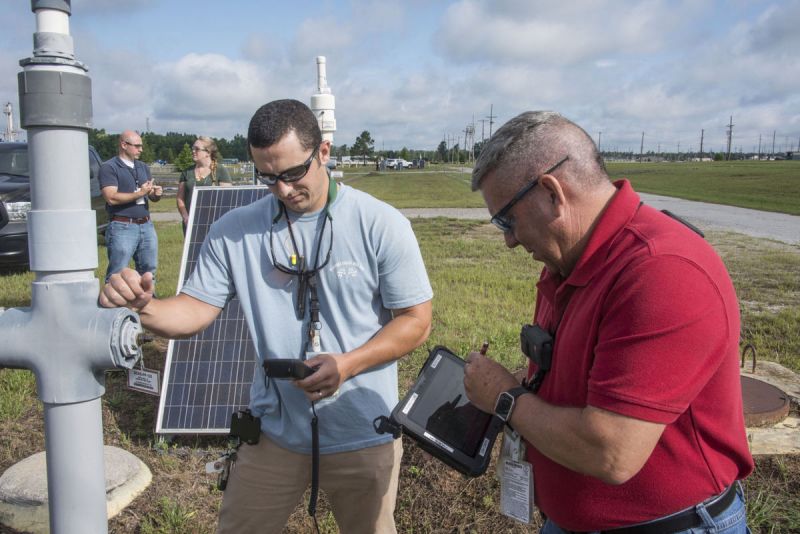Actively Pursuing Passive Cleanup Technology Pays Off at SRS
Published on by Water Network Research, Official research team of The Water Network in Technology
Savannah River Nuclear Solutions, or SRNS, personnel at the Savannah River Site continue to expand their use of passive groundwater cleanup systems that relies on nature to help lower costs, consume less energy and reduce carbon emissions.
“Using low-power, low-maintenance methods has proven to be a consistently viable cleanup option at SRS. It’s a matter of using the right tool for the right job. We want to be efficient and cost conscious while ensuring we have the full support of our environmental regulators as well,” said Mike Griffith, a project manager with SRNS, the site’s management and operations contractor.

Image: Savannah River Nuclear Solutions remote operators Matthew Easley, left, and Tony Craps take readings of a microblower used to remove underground chemical solvents. In the background, SRNS Senior Scientist Branden Kramer explains the solar-powered system to intern Sydney Goodlove.
Submitted Photo
“Years ago, one of our first groundwater cleanup approaches was to use active cleanup technologies to remediate potentially hazardous chemicals in groundwater under SRS,” Griffith said. “These systems required large amounts of electricity and frequent maintenance.”
SRS will continue to use the active pump-and-treat systems in small areas. As groundwater cleanup projects mature and the systems remove the bulk of contaminants, SRS is transitioning to more efficient technologies, such as solar-powered, soil-vapor extraction units. Each of these systems require between 20 and 40 watts of power, easily produced by a small solar panel.
“During a 10-month test, a single solar-powered unit removed 234 pounds of volatile organic compounds from chemically contaminated groundwater beneath SRS,” SRNS Senior Scientist Branden Kramer said.
SRS developed many of these technologies with EM’s Savannah River National Laboratory, working closely with the South Carolina Department of Health and Environmental Control and the U.S. Environmental Protection Agency.
Kramer acknowledged that the extraction units’ microblowers eventually will be replaced by a simpler system relying on changes in atmospheric barometric pressure to force chemical vapors from the underground through plastic pipes.
“We currently have 87 solar-powered and over 100 barometric soil-vapor units functioning at eight different locations on site,” Kramer said. “We’re down to just a few full-powered vapor-extraction units, so we’ve made significant progress towards low- or no power passive cleanup technology.”
Another SRS passive technology involves the injection of vegetable oil into the ground to promote the growth of naturally occurring bacteria. They aggressively consume the oil, along with chemicals such as solvents, accelerating the cleanup and saving millions of dollars.
Source: Aiken Standard
Media
Taxonomy
- Treatment
- Treatment Methods
- Purification
- Groundwater
- Groundwater Assessment
- Groundwater Pollution
- Groundwater Quality & Quantity
- water treatment
- Water Purification